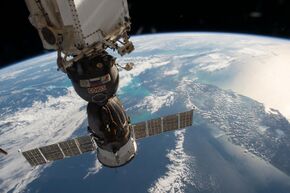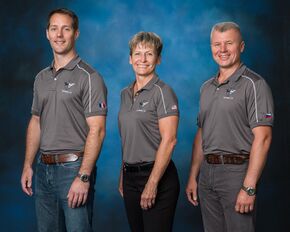Engineering:Soyuz MS-03
 Soyuz MS-03 docked to International Space Station (ISS). | |
| Mission type | ISS crew transport |
|---|---|
| Operator | Roskosmos |
| COSPAR ID | 2016-070A |
| SATCAT no. | 41864 |
| Mission duration | 196 days 17 hours 49 minutes |
| Spacecraft properties | |
| Spacecraft | Soyuz MS |
| Spacecraft type | Soyuz MS 11F732A48 |
| Manufacturer | RKK Energia |
| Launch mass | 7080 kg |
| Crew | |
| Crew size | 3 (launching) 2 (landing) |
| Members | Oleg Novitsky Thomas Pesquet |
| Launching | Peggy Whitson |
| Callsign | Kazbek |
| Start of mission | |
| Launch date | 17 November 2016, 20:17:00 UTC |
| Rocket | Soyuz-FG |
| Launch site | Baikonur, Site 1 |
| Contractor | Progress Rocket Space Centre |
| End of mission | |
| Landing date | 2 June 2017, 14:10 UTC |
| Landing site | Steppes of the Kazakhstan |
| Orbital parameters | |
| Reference system | Geocentric orbit |
| Regime | Low Earth orbit |
| Inclination | 51.66° |
| Docking with ISS | |
| Docking port | Rassvet nadir |
| Docking date | 19 November 2016, 21:58 UTC |
| Undocking date | 2 June 2017, 10:47 UTC |
| Time docked | 194 days |
 (l-r) Pesquet, Whitson and Novitsky Soyuz programme (Crewed missions) | |
Soyuz MS-03 was a Soyuz spaceflight launched on 17 November 2016.[1] It transported three members of the Expedition 50 crew to the International Space Station. MS-03 was the 132nd flight of a Soyuz spacecraft. The crew consisted of a Russian commander with American and French flight engineers.[2]
Crew
| Position[3] | Launching Crew Member | Landing Crew Member |
|---|---|---|
| Commander | Expedition 50 Second spaceflight | |
| Flight Engineer 1 | Expedition 50 First spaceflight | |
| Flight Engineer 2 | Expedition 50 Third (last NASA)[5] spaceflight |
N/A [4] |
Backup crew
| Position[6] | Crew Member | |
|---|---|---|
| Commander | ||
| Flight Engineer 1 | ||
| Flight Engineer 2 | ||
Mission highlights
Soyuz MS-03 launched with Expedition 50/51 on 17 November 2016, at 20:17 UTC. Astronaut Peggy Whitson, at age 56, became the oldest woman to fly into space.[7][8] Soyuz MS-03 docked at the International Space Station on 19 November 2016.[9] On 2 June 2017, Soyuz MS-03 undocked from the ISS, carrying Oleg Novitsky and Thomas Pesquet back to Earth after 196 days in space. Whitson remained on the ISS and returned on Soyuz MS-04 on 3 September 2017.
References
- ↑ "Soyuz MS-03 mission". http://russianspaceweb.com/soyuz-ms-03.html.
- ↑ "Display: Soyuz MS-03 2016-070A". NASA. 14 May 2020. https://nssdc.gsfc.nasa.gov/nmc/spacecraft/display.action?id=2016-070A.
 This article incorporates text from this source, which is in the public domain.
This article incorporates text from this source, which is in the public domain.
- ↑ "Error: no
|title=specified when using {{Cite web}}" (in ru). http://www.astronaut.ru/register/or_flight.htm. - ↑ Harwood, William. "Whitson's station expedition extended three months". Spaceflight Now. https://spaceflightnow.com/2017/04/05/whitsons-station-expedition-extended-three-months/.
- ↑ Potter, Sean (15 June 2018). "Record-Setting NASA Astronaut Peggy Whitson Retires". NASA. https://www.nasa.gov/press-release/record-setting-nasa-astronaut-peggy-whitson-retires.
 This article incorporates text from this source, which is in the public domain.
This article incorporates text from this source, which is in the public domain.
- ↑ astronaut.ru (2015). "Планируемые полёты" (in ru). http://www.astronaut.ru/register/or_flight.htm.
- ↑ "NASA's Peggy Whitson Becomes Oldest Woman in Space". ABC News. https://abcnews.go.com/US/nasas-peggy-whitson-oldest-woman-space/story?id=43641385.
- ↑ Chiara Palazzo (18 November 2016). "NASA veteran Peggy Whitson becomes the oldest woman in space as she blasts off for ISS". The Telegraph (Telegraph.co.uk). https://www.telegraph.co.uk/news/2016/11/18/nasa-veteran-peggy-whitson-becomes-the-oldest-woman-in-space-as/.
- ↑ "Welcome Aboard! New Arrivals Make Six Expedition 50 Crew Members | Space Station". https://blogs.nasa.gov/spacestation/2016/11/19/welcome-aboard-new-arrivals-make-six-expedition-50-crew-members/.
 This article incorporates text from this source, which is in the public domain.
This article incorporates text from this source, which is in the public domain.



